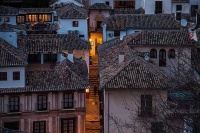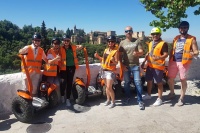
Sacromonte, Granada
The Sacromonte is famous for the gypsy caves, but the gypsies were neither the first nor the last people to live in them. Long before the Oriental nomads arrived in Spain, the Arabs had discovered that the soft stone of the hill was ideal for carving out underground homes, and gypsies simply moved into them after the conquest, as the Moriscos were expelled. In the 19th century, writers and artists of the Romantic Movement, most of them English and French travelers in search of picturesque oddities, immortalized the gypsies of the Sacromonte, who also inspired poets such as Lorca and De Falla.
When I first stayed in Granada as a student, 1961, the place was a filthy slum with gypsy kids running naked on the dirt paths. Since then, the traditional inhabitants have moved away to low-income housing projects in the north of the city, leaving the stage free for the next migratory wave: that of the artists and intellectuals (or if you wish, hippies and life-stylers) from the so-called industrialized countries, that is, us.
What an irony! The streets nowadays nicely paved and the caves have kitchens, toilets and telephones - some even have the sacrosanct Internet connections! I know one computerized Englishman, fellow interpreter who rents his very attractive grotto tucked away amongst the cactus trees for a price comparable to that of a flat in the center, and the owner, a painter who lives in the cave next door, is Japanese!
We can discover this more picturesque and scenic part of the Sacromonte by climbing a little higher along the Cuesta de Chapiz until we reach, on our left, the Placeta de Albaida, which we cross, taking on the far right hand side the Cuesta de Chinos (not the same ´´Slope of the Pebbles´´ as the one which goes up to the Alhambra) until we reach the charming walkway called Vereda de Enmedio, which overlooks the city like a balcony, with unforgettable views of the Albaicin and the Alhambra. Here we will undoubtedly catch a glimpse of the local gypsies who stayed on because they didn't want to live in the low income housing projects
But the only real street of the quarter is the Camino Del Sacromonte - the first on the right when you go up the Cuesta de Chapiz - along which you will find the updated version of gypsy flamenco caves or zambras, which I am told, varies greatly in quality. The truth of the matter is that the performers in these places are invariably excellent singers and dancers, but for commercial purposes tend to ´´play up´´ to the tourists in a rather embarrassing way. I never go myself because when I get an ´´itch´´ for flamenco I walk up the hill to the gypsy quarter of my village, Monterfrio, where I get it rough and raw.
In spite of what well-meaning hotel clerks may tell you, there is no special reason to be afraid in the Sacromonte. Most gypsies are not thieves and drug addicts, and in any case you can nowadays walk all over the place without seeing a single Cale as they call themselves.
You can walk all the way up the rather dilapidated Abbey itself, the ling brick building which we see on top of the hill, famous for its Boy´s School and Via Crucis, with the Stations of the Cross, each crucifix being the contribution of one of Granada´s guilds of craftsmen. At the summit we come to the Abbey and its church, neither of which are especially beautiful. But the view of Granada largely makes up for the desolate and arid appearance of the surroundings.
The story of how the hill became called ´´holy´´ (the translation of Sacromonte is Holy Mount) is particularly curious, and it also teaches us a great deal about the pitiful loss of the Moors of Granada after the conquest, as well as about the decadence of the Catholic Church in the 16th century.
This excerpt is from Granada, City of My Dreams - an artistic and historical guide for the curious traveler by Lorenzo Bohme
Buy your copy of - Granada, City of My Dreams
 Granada, City of My Dreams: An Historical and Artistic Guide to Granada and its Moorish Palace the Alhambra
Granada, City of My Dreams: An Historical and Artistic Guide to Granada and its Moorish Palace the Alhambra
This itinerary was written for Andaluca.com by Lawrence Boheme author of “Granada, City of My Dreams”. For, what fascinates us about this universal city is not only its monuments but its marvellous story, “the encounter between Moor and Christian, gypsy and Jew, medieval and Renaissance, glistening snow and Mediterranean sun. Lawrence Bohme, poet, illustrator and curious traveller, has filled these pages with luminous descriptions and drawings, the culmination of forty years of wanderings through the palaces and labyrinths. Amazon.co.uk or Amazon.es
Buy Tickets for tours in Sacromonte
Buy Tickets for tours in Sacromonte
Location
Sacromonto district of Granada





